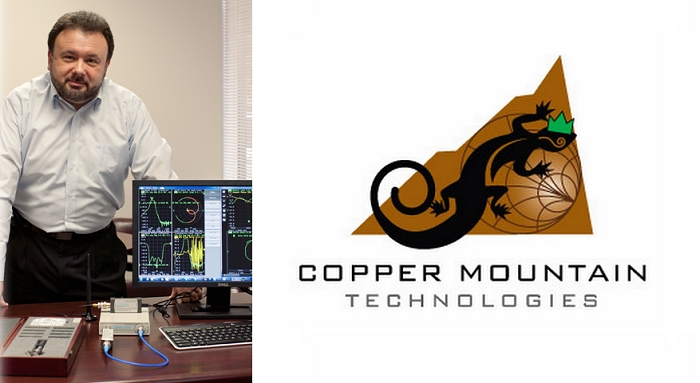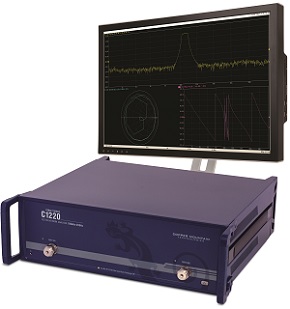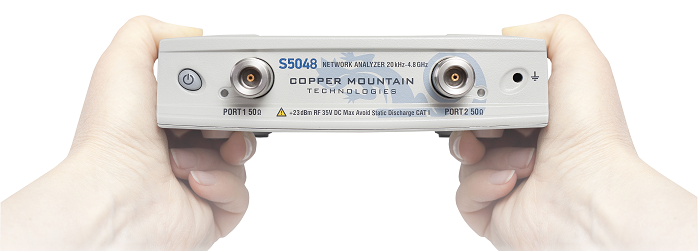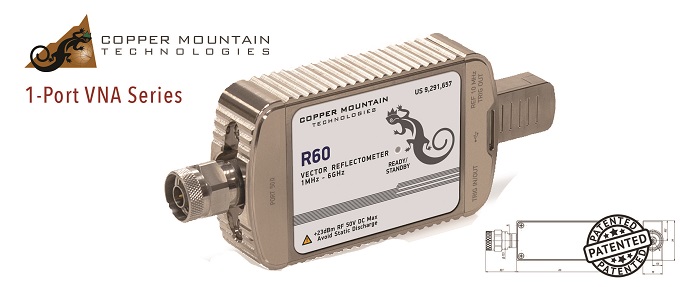
Alex Goloschokin is the Founder and Revenue Officer of Copper Mountain Technologies. Prior to starting the company in 2011 he served as Director of International Sales for JDSU Cable Test Division (now Viavi) and Lead Engineer at IPALCO. Alex holds an MSEE in Engineering Electrophysics from St. Petersburg Polytechnic University and a PE certification from the State of Indiana. He is a member of IEEE and frequent presenter at industry conferences.
Q. Can you give us a brief history about Copper Mountain Technologies?
Alex: Copper Mountain Technologies was started in 2011. The company is based in Indianapolis, IN, with a sales office in Singapore. Copper Mountain Technologies develops innovative and robust RF test and measurement solutions for engineers all over the world. Our VNAs are used for RF and Microwave applications from 9 kHz to 110 GHz by engineers in defense, automotive, materials science, medical, broadcasting and telecommunications, and other industries in the United States and around the world. Our customers range from government and defense agencies and contractors, like NASA, United States Armed Forces, Canadian DoD and law enforcement, to universities, mid-size manufacturers, like Reactel and PCTEL, and small companies with just a few employees. In 2015 Copper Mountain Technologies was recognized by Frost & Sullivan as a leader in RF test and measurement industry and received its Global Leadership in Innovation award. In 2016 the company moved to a new expanded office and established its own calibration laboratory that is accredited in accordance with the recognized international standard ISO/IEC 17025 (2005) and meets the requirements of ANSI/NCSL Z540-1994-1, ISO/IEC 9001:2008.
Q. What made you decide to enter the Vector Network Analyzer Industry?
Alex: Vector Network Analyzers were becoming more and more exclusive because of high price tag, and their size and weight were limiting their use to only certain benchtop applications. At the same time with proliferation of RF in our life the need for tests performed by VNAs was increasing. Our engineers created a new generation of VNAs by separating the measurement module from the processing module, utilizing external PCs and taking advantage of continued component and technology innovation. We wanted to help engineers realize their full potential by having access to precise, highly accurate, compact USB VNAs that perform as well or better than conventional instruments.
Q. Copper Mountain Technologies is a Pioneer in Modular or Computer Controlled VNA's. Can you give us some more information Modular VNA’s?
 Alex: Copper Mountain Technologies’ USB VNAs include an RF measurement module and a software application which runs on an external Windows PC, laptop or tablet, connecting to the measurement hardware via USB interface. The user can take advantage of the latest OS, processing power, larger display, and reliable performance of an external PC, as well as lower total cost of ownership and simplified maintenance of the analyzer. The result is a faster, more effective test process that fits into the modern workspace in lab, production, field and secure testing environments.
Alex: Copper Mountain Technologies’ USB VNAs include an RF measurement module and a software application which runs on an external Windows PC, laptop or tablet, connecting to the measurement hardware via USB interface. The user can take advantage of the latest OS, processing power, larger display, and reliable performance of an external PC, as well as lower total cost of ownership and simplified maintenance of the analyzer. The result is a faster, more effective test process that fits into the modern workspace in lab, production, field and secure testing environments.
Q. What are the advantages of a Modular VNA over Traditional VNA's made by Keysight & R&S?
Alex: Use of current technology and ability to easily upgrade as technology evolves: Rather than being locked into an old computer built into the VNA, users can take advantage of the latest OS, better processing power, faster speed, current communications and security protocols of new external PCs.
Lower Total Cost of Ownership: When something breaks in the VNA, most commonly it is computer related: a hard drive died, a screen got broken or it needs more memory. None of these potential failure points exist with the USB VNA, resulting in much lower cost of ownership over the life of your VNA.
Accessibility: We believe that it is critical for engineers to have access to equipment that allows them to do their best work. Our price point enables engineers to have more VNAs at the same level of investment. Functions that are typically high-cost add-ons in conventional VNAs come standard in our products, including time domain with gating. Instruments can be easily shared and used with multiple PCs. With the measurement module separate from the processing module, if the equipment needs to be repaired or replaced that can be done quickly and without losing previous test setup and results, eliminating work interruption.
Portability: USB VNAs are significantly smaller than traditional instruments since measurement module is separate from computing module and can even be incorporated as a built-in module into larger systems.
Performance: Since performance of a VNA is not driven by the location of the PC (internal vs. external to the analyzer housing), USB VNAs can perform as well as conventional VNAs.
Speed: Since test automation scripts run on the PC, not on the VNA, there’s no latency in data transfer of test results between various software applications, making it is easier to integrate a USB VNA into a test system.
Customization: USB instruments are much better suited to customization than conventional instruments as they make it easier to change connector type or position, dimensions and proportions of the housing, to meet the needs of the customer.

Q. Modular VNA's seem to be the logical choice for most applications. How has customer adoption been so far? Are Customers open to trying out this approach or are they hesitant to move away from the conventional VNA's?
Alex: What a difference five years make! In 2011 most users viewed a USB (sometimes also referred to as PC-based) VNA as a novelty and were not sure it would deliver. Today, USB instrumentation is becoming the norm, with more and more engineers using it, and more and more providers delivering USB versions of their traditional instruments, including power sensors, spectrum analyzers, and signal generators.
Today many customers are very open to this approach. Often they start by using a few instruments in the R&D environment and then, once they are comfortable with performance and reliability, expand their use into production as well.
Many more applications for VNAs are emerging that cannot be served by conventional VNAs. Here are a few examples:
In IoT, there is a variety of antennas and receivers that need to be small but have stable high performance. Originally the focus of IoT was on software, communications protocols, etc. but now the industry is beginning to focus more on hardware and working to establish good practices on design and production of IoT devices. With massive quantities required by IoT applications, low cost is an important driver. USB VNAs fit very well with IoT production and field testing applications.
There is increased interest in using VNAs in materials testing. Due to their weight and size conventional VNAs are almost impossible to use in these diverse applications which include dielectric materials testing, such as measuring humidity level in grain and wood, or identifying fractures in aircraft canopies.
Q. How is CMT educating the customer about this new approach?
Alex: We demonstrate how well our VNAs perform in advanced applications by working with individual organizations, authoring articles, presenting at conferences and trade shows, publishing application notes and videos on USB VNAs and by partnering with other USB instrument providers to host regional meetings demonstrating how different USB and PC-driven instruments can be easily integrated and used by engineers.
Q. Who are your customers? Are they smaller companies who used to rent equipment or buy second hand equipment or are they the large companies who use traditional equipment and see this as a more cost effective and flexible approach? What is the break up in terms of sales between these segments?
Alex: Our strategy is to focus on small and medium size customers who don’t get discounts from the big guys, and often have to buy used instruments. Our VNAs are accessible and affordable, and provide much better value than 10 to 15 year-old conventional VNAs, so we have been successful in generating significant sales from small/medium size customers.
For larger customers, we are a lot more successful in providing a solution to a problem where a conventional analyzer cannot: from a small handheld high performance 1-port analyzer, to specific applications where our form factor offers a better fit based on space/automation constraints, to insertable modules.
While universities have used our VNAs from the very beginning for research purposes, they are now increasingly using USB VNAs to outfit complete labs for teaching purposes: a USB VNA minimizes the time students need to spend in the lab and allows more students access to shared data acquisition modules. With the measurement module separate from data processing students can prepare for the lab and perform data post-processing off-site.
Q. Are you focusing on any specific geographic regions? What is your break up of Sales for within the US and Outside the US?
Alex: We are a global company. Our sales come from all over the world.
Q. CMT was granted a US Patent for Vector Network Analyzer Innovation in 2016. Can you tell us more about this?
Alex: The accuracy of VNA measurements, especially in the field, has always been degraded by the limitation of the measurement cables. Eliminating the need for test cable was the obvious way to significantly increase the accuracy and quality of VNA measurements, specifically in cable and antenna analysis. The key to solving this issue was to create a VNA that can provide lab-grade performance while always connecting directly to the DUT without the need for a test cable.
In 2011 we launched several 1-port VNAs (reflectometers) that fulfilled this requirement. In 2012 we filed for the patent and in 2016 were granted US patent for Measurement Module of Virtual Vector Network Analyzer number US 9,291,657.

Due to their measurement accuracy, ultra-compact size and elimination of a test cable Copper Mountain Technologies’ Reflectometers (cable and antenna analyzers) provide a wide variety of analysis capabilities and are ideal for use by specialists working with antennas and antenna feeders in the field, as well as laboratory and production testing in a wide variety of industries including design and production of various IoT hardware components, materials testing, medical devices, aerospace applications, etc.
Q. Up to what frequencies do your VNA's operate? Can they be used to address test and measurement requirements of mmWave applications and 5G applications?
Alex: Our VNAs operate in frequencies from 9 kHz to 110 GHz. Some of these solutions utilize frequency extenders. They can be used to address T&M requirements of mmWave and 5G applications as well as automotive radar, sensors, material characterization, antennas in single and multiple user arrangement.
Q. What kind of Software do you provide with the VNA's?
Alex: The software application is part of the VNA. It takes raw measurement data from the data acquisition (measurement) module and recalculates into S-parameters in multiple presentation formats utilizing proprietary algorithms. These new and advanced calibration and other accuracy enhancing algorithms were developed by our metrology experts. Our software can be downloaded free from our website, used by customers on an unlimited number of PCs, and enables easy VNA integration with other software applications and automation.
Q. What is next for CMT, are you planning on working on other T&M Products?
Alex: Our near-term roadmap is focused on Vector Network Analyzers. Our development team is very creative and continually generates new ideas, so we look forward to delivering new and exciting solutions to the industry.
Copper Mountain Technologies Company Profile on everything RF
Copper Mountain Technologies Product Overview